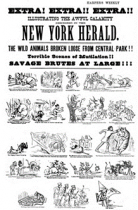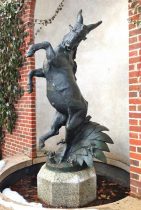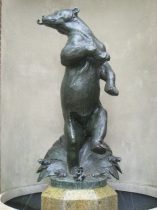Central Park Zoo and the History of the Menagerie
When thinking about Central Park in New York City; One of the most iconic landmarks is the Central Park Zoo. The Central Park Zoo is located on the south-eastern corner of Central Park and hosts on the lower end 1.5 million visitors a month and in the summer during peak months upwards of 4.5 million visits a month with around 10% of these visitors going into the Central Park Zoo.[1] With this incredible amount of attraction one begins to wonder if the Central Park Zoo has always had this amount of prestige and public interest. To do this we have to go back to 1864 when the municipal zoo opened and examine its adventure as it lives through renovations, public opinion shifts, and a mysterious case of missing animals.
While the Central Park Zoo that many know today was established in 1934 the history of this zoo gets its start in the late 1800’s under the name of the Central Park Menagerie. The vision of the Menagerie was started by financier August Belmont, member of the Central Park Board, in 1859 convinced the commissioner to look into adding a zoo into the park and in about a years’ time he and other wealthy gentlemen; including, Frederick Law Olmsted, one of the original designers of Central Park, organized the American Zoological and Botanical society to plan this menagerie. This society would be approved by state legislatures as well a 60 acres of land in Central park for the purposes of a zoological and botanical garden.[2] The menagerie was met with great success, after a renovation in 1870 there were two and a half million visitors attracted to the zoo, which equated to about a quarter of all those who came to the park.[3] In part this popularity was due to the admission price, which was an affordable fee of free. While this was an attractive selling point for the working-class citizens, authors Roy Rosenzweig and Elizabeth Blackmar cite that, “critics derided the ‘ill-assorted’ menagerie, claiming it attracted a ‘rabble of curiosity seekers’ and was ‘useless’ for education.”[4] This shows the class dissonance in New York City during this time. The elite wanted this menagerie to be private, for only those who have class, not just anybody who wants to see a monkey. Despite the criticisms of the elite this controversy surrounding the ‘rabble of curiosity seekers’ would not hinder the menagerie and it would continue to see much success in its operations. By 1890 the zoo had a total of 907 animals consisting of 432 mammals, 419 birds, and 56 reptiles; with plans to build a new aviary to better accommodate the birds. Among these animals the Director of the menagerie makes special note of, “…a Three-toed sloth…, an electric Eel…, an American civet cat…, a pair of young Elks…, a sea lion…, and one Hippopotamus…”[5] The menagerie hosted many exotic animals bringing a new experience to all who wanted to see in New York. This coupled with the free admission it is clear to see why the menagerie was such a big hit with the city’s residences.
The menagerie saw a lot of good press from the news. For the most part writing about the animals was easy, writing about significant events in the animals lives such as births or relationships, and people loved reading about them. The animals in the menagerie were a huge attractor of good attention. That is until 1874 in which a newspaper by the name of The Herald would publish a piece with the name “Awful Calamity: The Wild Animals Broken Loose from Central Park.” The newspaper article detailed an unfortunate series of events that led to all of the wild animals being freed, not only freed but, “One after another the animals leaped from the menagerie and scattered themselves over the city killing or mutilating beasts, men, and women all over town.” [6] Illustration 1 shows off the illustration that accompanied this headline, a sketching of the timeline of events in cartoon form. This event would spell disaster for the menagerie. Or it would have would this event really occurred. As it would turn out, the whole article was made up by T.B. Connery managing director of The Herald. The hoax can be better explained by author Robert Bartholomew and Benjamin Radford in their book, “The Martians Have Landed!” this hoax was meant to, “…Jolt New Yorkers out of their apathy to do something about the poor state of the Central Park Zoo before real disaster occurred.” Of course this only became clear to readers if they read the entire article and not just the headings, which many did just the latter.[7] Unfortunately for the zoo animals because no one read to the end and believed this hoax nothing more came out of this event than a hectic morning.

Despite controversy and hoaxes the menagerie would continue to be a great attraction in Central Park, the park would remain public open to anyone who wanted visit. This menagerie would set the groundwork for what would later become the Central Park Zoo remaining open to the public before its last renovation/conversion in 1934.
The menagerie would be converted into a proper municipal zoo in late 1934. In November 23, 1934 in a press release by the Department of Parks for NYC stated the opening day for the new Zoo would be December 2nd. Attending this event would be many important figures such as the mayor, Fiorello LaGuardia; the former governor, Alfred Smith; Coosaissioner of Parks; Robert Moses, and the chairman of the New York State Temporary Emergency Relief Administration; Alfred Sehoelkopf.[8] Needless to say that this renovation and opening was a huge event. The menagerie was already a big hit with the populace to have it be renovated and made into something better created huge amounts of excitement. The new renovations would completely replace the, “…former jangle of unsightly firetraps…” and the, “structurally dangerous, unhealthy, unsanitary, and entirely inadequate housing [for] wild animals.”[9] The new renovation would take the shape of what Central Park looks like today, illustration 2 shows what the main entrance of the zoo looked like on opening day. Some of this original renovations can still be seen today such as Dancing Goat and Dancing Bear statues by Frederick Roth seen in illustrations 3 and 4.

The zoo would go through another renovation in 1988 the last major renovation to add an exhibits to the zoo until 2009 when a snow leopard exhibit was added. This renovation was important as it adds a lot more detail into the story of the zoo and how the public perceived it. Through a New York Times article by Susan Anderson titled, “At Last, a Joy for All Ages; Central Park Zoo is Back.” This article shows that the zoo was split into three parts depending on the climate zone, much like it is today. We also see that many large mammals, such as elephants, were removed due to

space issues. This is also consistent in what we see at the zoo today mostly consisting of smaller animals such as red pandas, snow monkeys and sea lions.[10] Another common theme that needs to be pointed out here is again that lack of space, while every iteration of the menagerie and zoo seems to claim that they are improving conditions when each of these renovations is continually it begs the question on if the safety and comfortability of the animals is ever addressed.
Today the Central Park Zoo is one of the most visited attractions in Central Park. It brings together the appeal of seeing cute animals that are nonnative to the city or country. It also as the Nations first public zoo holds large historical value.[11]The zoo is home to many species of animals, housing six different exhibits including a petting zoo for the children. With animals ranging from red pandas to snow leopards to Japanese Macaque and Sea Lions there is something there for any animal lover. The Zoo is also only 6.5 acres large which makes it incredibly easy to see all of the exhibits in a timely manner. The Zoo is open all week at varying times and only costs 14 dollars to gain access to all of the exhibitions and history the site has to offer.
[1] Kornblum, William. 2011. Report On The Public Use of Central Park. New York. Pg. 7
[2] Blackmar, Elizabeth and Rosenzweig, Roy. 1992. The Park and the People: A History of Central Park. Pg 341.
[3] Ibid, 344.
[4] Ibid, 344.
[5] Central Park Menagerie and New York (N.Y.). 1890. “Report of the Central Park Menagerie,” pg. 6.
[6] Hapgood, Norman, George Brinton McClellan Harvey, John Kendrick Bangs, Henry Loomis Nelson, Carl Schurz, Richard Harding Davis, John Foord, et al. 1857. “Harper’s Weekly.,” 1857. Pg. 532
[7] Bartholomew, Robert E. 2012. The Martians Have Landed!: A History of Media-Driven Panics and Hoaxes. Jefferson, N.C. ; London: McFarland.
[8] Unknown Author. 1934. New York City Department of Parks Press Releases, August- December 1934. Transcribed by Frank Da Cruz. New York.
[9] Ibid.
[10] ANDERSON, SUSAN HELLER. 1988. “At Last, a Joy for All Ages: Central Park Zoo Is Back: Central Park’s Zoo Reopens.” New York Times, 1988.
[11] Sara Cedar Miller. 2020. Seeing Central Park : The Official Guide Updated and Expanded. New York: Abrams.

It’s too expensive for me now. I can’t go to the zoo anymore.